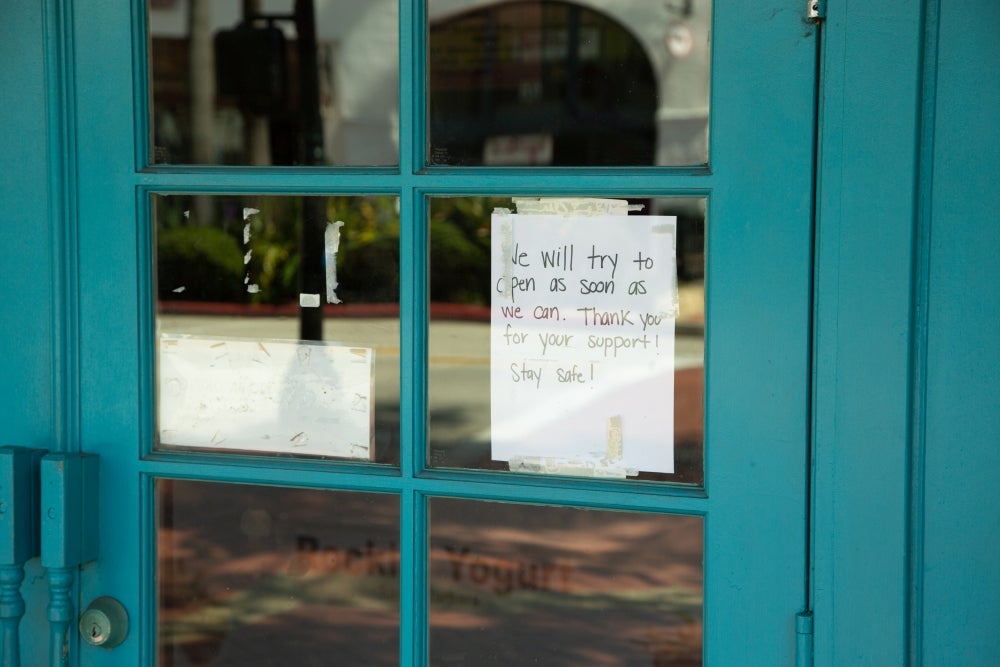
COVID-19 and Commerce

Coronavirus is changing how and where we do business; working from home may become more the norm for some, and how is State Street faring in this economic storm? These were some of the topics the guests at the recent EFP Informs webinar grappled with, as they focused on rapid changes in the commercial real estate world.
“Before the pandemic started most economists just kind of sat in their chair for a month until new data came out for the quarter,” said Peter Rupert, UC Santa Barbara economics professor and director of the Economic Forecast Project, which produces the webinar series. “Now you’re just bombarded with data.”
And it’s all over the place, too. Stocks dropped like a rock last month in the wake of a record-setting 32.9% drop in GDP for the second quarter; now they’re gaining steam again, due in part to hope for a coronavirus vaccine.
“Many economists are forecasting a third-quarter GDP growth by 30%,” Rupert said. “So we had the largest decline ever in the history of the United States. And we’re probably going to see the largest increase we’ve ever seen in the history of the United States.” Meanwhile, nationwide unemployment claims, after weeks of decreasing, are back on the rise and it remains to be seen how the most recent $300/weekly stimulus unemployment program will play out.
Commercial real estate took a hard hit at the onset of the pandemic, and recovery is at a crawl but looking up said Chris Ludeman, from his vantage point as global president of CBRE, the world’s largest commercial real estate services company. Business fell precipitously by the third week of March, amid widespread stay-at-home orders and uncertainty about the future.
“The market is starting to get much more active now,” he said. “The major money center banks have largely been pencils down on debt, although we’re starting to see signs that they’re about ready to come back into the market.”
The $2.2 trillion CARES Act — the economic stimulus bill passed by Congress in March — helped many commercial tenants stay on top of rent, Ludeman continued, particularly those leasing office, and multifamily spaces.
At the other end of the continuum, higher density operations, such as retail and hospitality continue to struggle, as proprietors cope with social distancing measures and pandemic-driven uncertainties.
Bob Tuler knows this well. As principal and founder of Radius Commercial Real Estate, he’s had his sights on the problem of retail vacancies in the Santa Barbara area. Typically somewhere in the neighborhood of 1% and 2% in Santa Barbara County, he said, vacancies in the county began to creep upward a couple years ago to 3% and higher.
“The vacancy rate right now, which is right around three and a half percent at the end of the second quarter, does not reflect how may retail tenants are struggling and are about to close,” he said. State Street is a particularly stark reminder: Despite a move to close Santa Barbara City’s main commercial thoroughfare to cars in order to make room for outdoor dining, State Street’s 14% vacancy “could be as high as 18%” before the year is out, according to Tuler.
Other commercial zones, on the other hand, seem to be faring better than downtown State Street, Tuler added. Coast Village Road in the Montecito area, upper De la Vina and Milpas, and Camino Real Marketplace in Goleta seem to be holding steady, due in large part to their drive-up locations, he said.
The sudden pivot to working from home has caused companies and workers to reconsider their office space needs, said Francois DeJohn, founder of Hayes Commercial Group.
“I’m starting to see, for want of a better word, some cracks,” he said. “There are people starting to make decisions on how much space they really need; are they going to be coming back? Can they operate in less space?” One major lessee in Goleta is expected to announce the closure of their offices for good and let go of 80,000 square feet of office space, he said.
Still, while there will likely be more flexibility between working from home and working in an office, but probably not a dramatic shift away from going to the office, DeJohn predicted.
“We were looking at office spaces as a way to attract and retain the best talent,” he said. “Those things don’t go away. It’s hard to build a culture remotely.”
Uncertainty still clouds the future, as people wait on a potential second federal stimulus package, grapple with unemployment, and hope for a coronavirus cure or vaccine.
Meanwhile, the pandemic will continue to drive decisions about real estate, both commercial and residential (more on that in an upcoming webinar). Hotels, particularly the large convention spaces and luxury destinations, are in dire straits, while smaller hotel operations seem to be squeaking by. Retail spaces may convert into office spaces, said the panelists, and office spaces may change to make it easier to conform to social distancing rules and other coronavirus safety measures.



